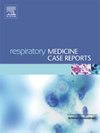Metastatic tracheal melanoma misdiagnosed as chronic obstructive pulmonary disease: A case report
IF 0.7
Q4 RESPIRATORY SYSTEM
引用次数: 0
Abstract
Introduction/objective(s)
Metastatic tracheal melanoma is rare, with fewer than 20 reported cases. This case describes a 62-year-old female with a history of cutaneous melanoma excised 10 years prior, initially misdiagnosed with severe COPD. We highlight the diagnostic challenges when rare metastases mimic common conditions.
Description
Diagnosed with COPD based on dyspnoea and spirometry, the patient later developed worsening symptoms, including haemoptysis, requiring hospitalisation. A chest radiograph was unremarkable, but CT pulmonary angiogram revealed a 1.6 × 1.3 cm tracheal mass. Bronchoscopy confirmed 80–90 % luminal stenosis due to a friable mass, which biopsy identified as tracheal melanoma (BRAF V600E positive). She underwent tumor debulking via rigid bronchoscopy, followed by radiation therapy and vemurafenib.
Discussion
This case represents the longest interval between cutaneous melanoma and tracheal metastasis. Spirometry showed a COPD-like scooping pattern rather than the expected large airway obstruction, delaying diagnosis. New-onset severe airflow obstruction in patients with minimal smoking history should prompt alternative considerations. Advanced imaging and bronchoscopy are essential for early detection. Treatment includes surgical debulking, radiation, and targeted therapy, with follow-up showing symptom resolution and normalised spirometry.
Conclusion
Metastatic tracheal melanoma can mimic COPD, leading to misdiagnosis. The prolonged latency highlights the need for vigilance in melanoma follow-up. Rare airway lesions should be considered in atypical COPD presentations, reinforcing the importance of advanced diagnostic tools for timely identification and treatment.
转移性气管黑色素瘤误诊为慢性阻塞性肺疾病1例
简介/目的:转移性气管黑色素瘤是罕见的,报道病例少于20例。本病例描述了一名62岁女性,10年前切除皮肤黑色素瘤病史,最初误诊为严重COPD。我们强调诊断挑战时,罕见的转移模仿常见的条件。根据呼吸困难和肺活量测定诊断为COPD,患者后来出现咯血等症状恶化,需要住院治疗。胸片未见明显变化,但CT肺血管造影显示1.6 × 1.3 cm气管肿块。支气管镜检查证实80 - 90%的管腔狭窄是由易碎肿块引起的,活检确定为气管黑色素瘤(BRAF V600E阳性)。她通过刚性支气管镜切除肿瘤,随后进行放射治疗和vemurafenib。本病例为皮肤黑色素瘤与气管转移之间间隔时间最长的病例。肺活量测定显示copd样铲型,而不是预期的大气道阻塞,延误了诊断。无吸烟史的患者新发严重气流阻塞应提示其他考虑。先进的影像学检查和支气管镜检查对早期发现至关重要。治疗包括手术减积、放疗和靶向治疗,随访显示症状消退和肺活量恢复正常。结论转移性气管黑色素瘤可模拟慢性阻塞性肺病,导致误诊。延长的潜伏期突出了黑素瘤随访时警惕的必要性。在非典型COPD表现中应考虑罕见气道病变,强调先进诊断工具对及时识别和治疗的重要性。
本文章由计算机程序翻译,如有差异,请以英文原文为准。
求助全文
约1分钟内获得全文
求助全文
来源期刊

Respiratory Medicine Case Reports
RESPIRATORY SYSTEM-
CiteScore
2.10
自引率
0.00%
发文量
213
审稿时长
87 days
 求助内容:
求助内容: 应助结果提醒方式:
应助结果提醒方式:


